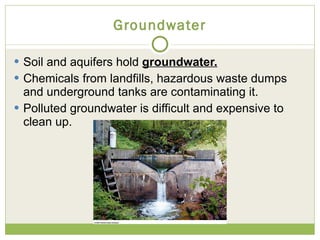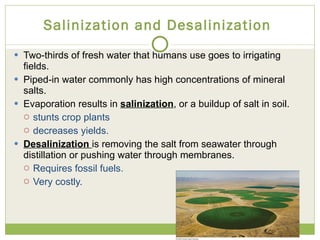Ecosystems
- 1. Chapter 47 Table 1 Period 4 Ecosystems
- 2. Ecosystem An association of organisms and their physical environment, interconnected by ongoing flow of energy and a cycling of materials (open system)
- 3. Simple Ecosystem Model Ecosystems include deserts, hardwood forests, tundra, prairies, reefs, oceans, streams, lakes, ect. These ecosystems run on energy that autotrophs produce by photosynthesis. Ex. Plants and Phytoplankton They are called primary producers. Every other organism is called a consumer or heterotrophs.
- 4. Consumers Herbivores - have a strict diet of only plants…(Red fox) Carnivores - have a strict diet of only flesh…(Crocodiles) Parasites - live in or on their host and feed on its tissue…(Fleas) Scavengers - feeds on dead and decaying animals…(vultures) Detritivores such as earthworms and crabs feed on detritus (decomposing organic matter). Decomposers break down organic remains and wastes of other living organisms. Omnivores - feed on plants, animals and microbes . Omnivores consume two or more types of organisms.
- 5. Trophic Levels Trophic level - the level on the food chain on which an organism is. Food chain - Linear sequence of steps by which energy stored in autotroph tissues enters higher trophic levels.
- 6. Food Webs a community of organisms where there are several interconnected food chains.
- 7. Two Types of Food Webs Chapter 47 Producers (photosynthesizers) Energy Input: Energy Input: herbivores carnivores decomposers decomposers detritivores Energy Output Energy Output energy losses as metabolic heat & as net export from ecosystem Producers (photosynthesizers) decomposers detritivores Transfers: Transfers: energy in organic wastes, remains Grazing Food Web Detrital Food Web Producers (Photosynthesizers) Producers (Photosynthesizers) Herbivores Carnivores Decomposers Decomposers Detritivores
- 9. Pesticides Many plants have natural toxins that repel herbivores, but do not harm them. We do not get sick or die from the toxins because toxicity is a function of concentration. In 1945, scientists started to make synthetic toxins & to identify mechanisms by which toxins attack pests. herbicides- kill weeds by disrupting metabolism & growth. insecticides- clogs airways of target insects, disrupts its nerves & muscles, or prevent its reproduction. fungicides- works against harmful fungi.
- 10. DDT It takes two to fifteen years for this nerve cell poison to break down. Insoluble to water. Can easily disperse in vapor form. Highly soluble in fats, so can accumulate in tissues of consumer's organs. Can show biological magnification – the ever increasing concentration of a slowly degradable or nondegradable substance in body tissues as it is passed along in food chains
- 11. DDT Disrupts metabolic activities & are toxic to many aquatic and terrestrial animals. No one predicted the effects of DDT, it was incriminally killing the natural predators that keep pests in check. Effects started to show up in habitats far removed from DDT and much later in time.
- 12. Most Vulnerable Victims Brown pelicans Bald eagles Peregrine falcons Other top carnivores
- 13. DDT DDT breakdown interferes with some physiological processes. Some birds still lay thin-shelled eggs since the ban in the 1970s. DDT from industrial waste discharges that had stopped twenty years earlier still contaminate ecosystems today.
- 14. Energy Flow Through Ecosystems primary productivity - the rate at which producers capture & store energy in their tissues during a given interval. How much energy stored depends on: amount of producers. balance between photosynthesis & aerobic energy (balance between energy trapped & energy used). gross primary production - energy initially trapped by producers. net primary production - fraction of trapped energy that producers funnel into growth & reproduction. net ecosystem production - the gross primary production minus the energy used by producers & soil decomposers Factors that impact net production: seasonal patterns distribution through habit
- 15. Biomass Pyramid Depicts the dry weight of all of an ecosystem's organisms at each tier.
- 16. Energy Pyramid Model Illustrates how the amount of usable energy diminishes as it is transferred through an ecosystem. Energy transfers are never 100 percent efficient. Some energy is lost as heat. Some biomass is not digested. Some energy is lost at each step. Limits the number of trophic levels in an ecosystem . 21 383 3,368 20,810 kilocalories/square meter/year top carnivores carnivores herbivores producers decomposers + detritivores = 5,080
- 17. Biogeochemical Cycles An essential element moves from the environment, through ecosystems, then back to the environment. No other element can directly or indirectly fulfill the metabolic role of such elements, or nutrients, which is why we call them essential. Ex. oxygen, hydrogen, carbon, nitrogen, and phosphorus. Nutrients move into and out of ecosystems by way of natural geologic processes. Decomposers help cycle the nutrients in ecosystems.
- 18. Biogeochemical Cycles There are three types of biogeochemical cycles. Portions of the environment are reservoirs for specific elements. Hydrologic cycle – oxygen and hydrogen move on a grand scale, in molecules of water. Atmospheric cycles – some gaseous form of the nutrient is the one available to ecosystems. Include the Carbon Cycle and the Nitrogen Cycle . Sedimentary cycles – Phosphorus and other solid nutrients accumulate on the seafloor and eventually return to land through geological uplifting, which usually takes millions of years.
- 19. biogeochemical cycle Main nutrient reservoirs in the environment fraction of nutrient available to ecosystem primary producers herbivores, carnivores, parasites detritivores, decomposers
- 20. Environmental Reservoirs Portions of the environment are reservoirs for specific elements .
- 21. The Water Cycle The hydrologic cycle . Water slowly moves on a global scale from the world ocean – the main reservoir – through the atmosphere, onto land, then back to the ocean. Water moves nutrients into and out of ecosystems. A watershed is any region where precipitation flows into a single stream or river. Ecologists measure nutrient inputs and outputs in forests through watersheds. Main Reservoirs Volume (10 3 cubic kilometers) 1,370,00029,000 4,000 230 67 14 Oceans Polar ice, glaciers Groundwater Lakes, rivers Soil moisture Atmosphere (water vapor)
- 22. Overview of Hydrologic Cycle Atmosphere Ocean Land evaporation from ocean 425,000 precipitation into ocean 385,000 evaporation from land plants (evapotranspiration) 71,000 precipitation onto land 111,000 wind-driven water vapor 40,000 surface and groundwater flow 40,000 Figure 47-15 Page 853
- 23. EVAPORATION PRECIPITATION TRANSPIRATION dripping, trickling down along stems falling through to ground interception by plants surface pooling, etc. infiltration of soil moisture in soil seepage, percolation groundwater storage DEEP OUTFLOW overland flow lateral flow base flow STREAM OUTFLOW Fig. 47-16, p.853
- 24. Groundwater Soil and aquifers hold groundwater. Chemicals from landfills, hazardous waste dumps and underground tanks are contaminating it. Polluted groundwater is difficult and expensive to clean up.
- 25. Groundwater Overdraft and Pollution
- 26. Salinization and Desalinization Two-thirds of fresh water that humans use goes to irrigating fields. Piped-in water commonly has high concentrations of mineral salts. Evaporation results in salinization , or a buildup of salt in soil. stunts crop plants decreases yields. Desalinization is removing the salt from seawater through distillation or pushing water through membranes. Requires fossil fuels. Very costly.
- 27. The Carbon Cycle Carbon moves through the lower atmosphere and all food webs on its way to and from its large reservoirs. Carbon reservoirs: Earth’s crust holds the vast majority of carbon. The Ocean is the next largest reservoir. Most of the annual cycling of carbon occurs between the ocean and the atmosphere. Carbon moves into and out of ecosystems mainly when combined with oxygen. Ex. Carbon dioxide, bicarbonate, and carbonate.
- 28. Carbon Cycle - Marine incorporation into sediments diffusion between atmosphere and ocean bicarbonate and carbonate in ocean water marine food webs marine sediments combustion of fossil fuels death, sedimentation uplifting sedimentation photosynthesis aerobic respiration
- 29. Carbon Cycle - Land photosynthesis aerobic respiration terrestrial rocks soil water land food webs atmosphere peat, fossil fuels combustion of wood sedimentation volcanic action death, burial, compaction over geologic time leaching, runoff weathering combustion of fossil fuels
- 30. Carbon in the Ocean The ocean holds 38,000-40,000 gigatons of dissolved carbon. Ocean currents carry carbon primarily in the form of bicarbonate and carbonate ions.
- 31. Carbon in the Atmosphere Atmospheric Cycle Atmospheric carbon is mainly carbon dioxide Added by aerobic respiration , volcanic action, burning fossil fuels Removed by photosynthesis Carbon is a greenhouse gas. Greenhouse gases impede the escape of heat from Earth’s surface and make life on earth possible. The greenhouse effect - As heat builds up in the lower atmosphere, the Earth’s temperature rises.
- 32. Global Warming Wavelengths in rays from the sun penetrate the lower atmosphere and warm the earth’s surface.
- 33. Global Warming - The surface radiates heat (infrared wavelengths) to the atmosphere where some of it escapes to space. - Greenhouse gasses and water vapor trap infrared energy and radiate a portion of it back toward the Earth.
- 34. Global Warming - Increased concentrations of greenhouse gasses trap more heat near the earth’s surface and more water vapor evaporates into the atmosphere. - Results in global warming - a long term increase in temperature near Earth’s surface.
- 35. Global Warming Long term increase in Earth’s lower atmosphere over time.
- 36. Nitrogen Cycle Atmospheric cycle Nitrogen moves from its largest reservoir (the atmosphere ), through the ocean, ocean sediments, soils, and food webs, then back into the atmosphere. Nitrogen is used in amino acids and nucleic acids.
- 37. Nitrogen fixation Starts the Nitrogen Cycle. Plants cannot use nitrogen gas. Bacteria attached to the roots of plants convent gaseous nitrogen (N 2 ) to ammonia (NH 3 ). The ammonia is then converted to ammonium (NH 4 +) and nitrate (NO 3 - ). Most plants easily take up these two forms of nitrogen.
- 38. Other processes affecting the Nitrogen Cycle Ammonification – soil fungi and bacteria decompose nitrogen-containing compounds ammonia and ammonium. Nitrification – bacteria convert ammonia and ammonium to nitrite and nitrate, which plants can absorb. Denitification - conversion of nitrate and nitrite to gaseous nitrogen (N 2 ) or nitrogen oxide (NO 2 ) certain soil bacteria.
- 39. Overview of Nitrogen Cycle gaseous nitrogen (N 2 ) in atmosphere NO 3 - in soil nitrogen fixation by industry fertilizers NH 3 - ,NH 4 + in soil 1. Nitrification leaching uptake by autotrophs excretion, death, decomposition uptake by autotrophs nitrogen fixation leaching ammonification 2. Nitrification dentrification nitrogenous wastes, remains NO 2 - in soil food webs on land
- 40. Phosphorus Cycle A sedimentary cycle . Phosphorus (mainly phosphate) moves from land, through food webs, to ocean sediments, then back to land. Earth’s crust is the largest reservoir of phosphorus. Occurs over millions of years. Weathering and erosion deliver phosphate ions to streams and rivers. Rivers take them to the sea. The ions accumulate and for insoluble deposits on submerged continental shelves. After millions of years, crustal movements may uplift parts of the seafloor and expose the phosphate on land surfaces.
- 41. Flow of Phosphates through Food Chains Phosphates are required to form ATP . Plants take up dissolved phosphates from soil water. Herbivores obtain phosphate from eating plants. Carnivores obtain phosphate from eating herbivores. Animals lose phosphate in urine and waste. Decomposers release phosphate from organic wastes and remains. Plants take the phosphates up again.
- 42. Overview of Phosphorus Cycle guano fertilizer terrestrial rocks land food webs dissolved in seawater marine food webs marine sediments excretion weathering mining agriculture uptake by producers death, decomposition sedimentation settling out leaching, runoff weathering uplifting over geologic time dissolved in soil water, lakes, rivers uptake by autotrophs death, decomposition









































